- 1 - Besisahar to Khudi: Most People Walk Further to Work
- 2 - Who Says Trekking in Nepal Has to Involve Lots of Walking?
- 3 - Conquering the Annapurna Circuit’s First Hill
- 4 - Trek to Jagat and a Rant Against Guides on the Annapurna Circuit
- 5 - Jagat to Tal: Our First Real Day of Trekking
- 6 - Tal to Chame: Falling into a Trekking Routine
- 7 - Chame to Pisang: Just Takin’ the Goat for a Walk
- 8 - A Well-Deserved Day Off in Upper Pisang
- 9 - Pisang to Ngawal: A Hard Climb to Beautiful Views
- 10 - Drinking Yak Sewage in Ngawal
- 11 - Arriving In Manang…Two Weeks Later Than Most
- 12 - Trekking On Our Day Off From Trekking in Manang
- 13 - Annoying Trekker Abuses Friendly Guesthouse Owner
After my apparently trend-setting ice bucket shower and a quick breakfast, we headed out. This was the day that would take us to Manang, the largest town on the Annapurna circuit trek and generally seen as the halfway point. It is also the last bastion of civilization before the Throng Lo Pass. Manang sits down in the valley, which meant we would have to descend back down to the lower trail and lose the 400 meters we worked so hard to gain the previous day. The views from the upper trail definitely made up for the trouble though.
We hiked down a dusty slope among red, yellow and green bushes and large needle trees (I was going to write fir trees, but I have no idea if that’s actually what they were; look at the pictures below—maybe you can help me). Despite the dust, this ended up being my second favorite day of the trek, right after the previous one. The weather was perfect again and the scenery had us stopping to take photos every 20 steps. This mountain in particular—Annapurna III, I believe—features in well over a hundred of my photos:
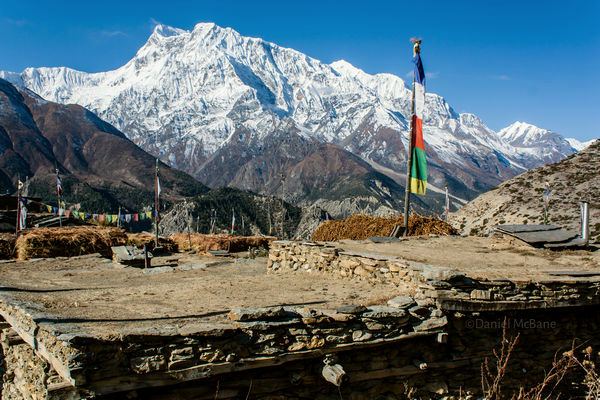
Annapurna III towering over the rooftops of Ngawal.
We took our time and enjoyed the relatively easy walk. Once we were back down in the valley, the enjoyment diminished a bit. Walking along the main road was not as pleasant as the smaller trails we had enjoyed for the past two days. While there was no motorized traffic (apparently this has since changed), there were a lot of people, horses and donkeys. Then there was the wind.
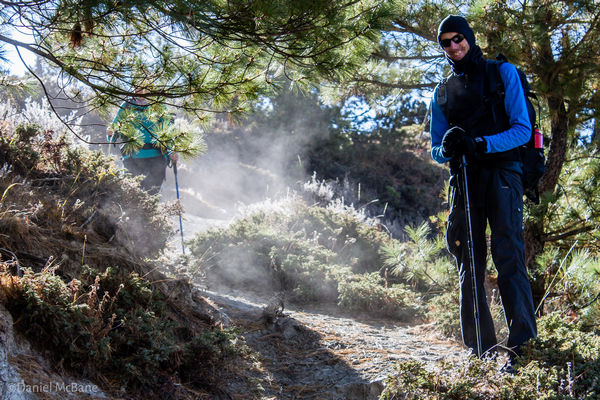
The dusty descent. Don’t let his outfit fool you—it was nowhere near that cold. Germans are always freezing.
The Manang valley is famous for its afternoon winds and they were blowing quite nicely on this day, kicking up dust all around us. That said, they were coming from behind and I wasn’t complaining about the boost as they helped us along.
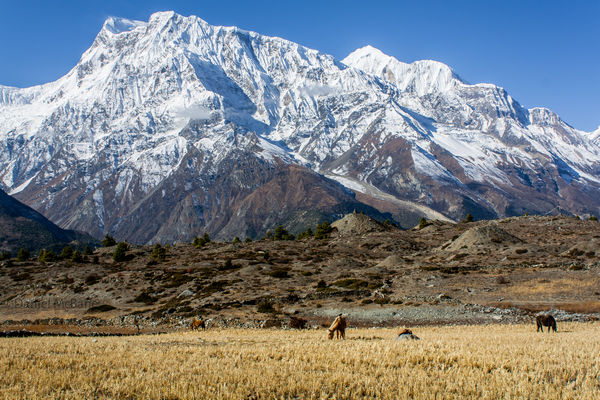
Annapurna III again…
We passed a smaller town or two and briefly considered getting a room for the night. A lot of the trekking groups were doing so in order to avoid a night in Manang—at least that was the official reason. In reality, the trekking company guides were getting kickbacks from the hotels in those towns to take their groups there. Manang is not the nicest place along the trek, but seeing these other towns, dusty and windy as they were, I’m glad we decided to continue on.
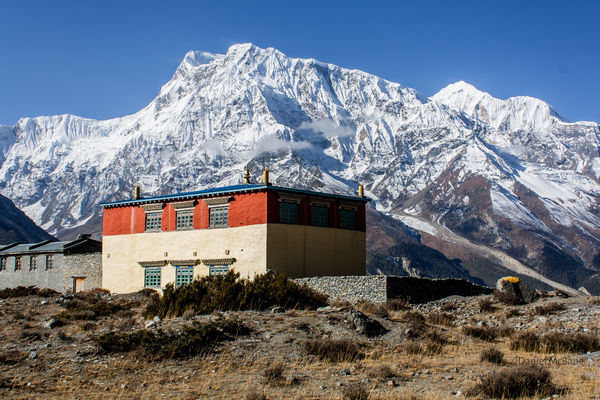
…once more, this time behind a monastery…
And I say that knowing what I know now: Manang was easily our worst overnight stop on the Annapurna Circuit. Despite that, it is the place where most people spend an extra day to adjust to the altitude, since it is the last town before the Throng Lo Pass. Most trekkers spend the day off stocking up on supplies, watching movies (Manang has two movie theaters showing a selection of films I either never want to see or never want to see again—if I remember correctly, this included Avatar, 2012 and one of the 20 or so Transformer movies), using the incredibly expensive internet cafes (at the time, this was only the second town with internet) or embarking on one of several possible side treks to further help with altitude adjustment.
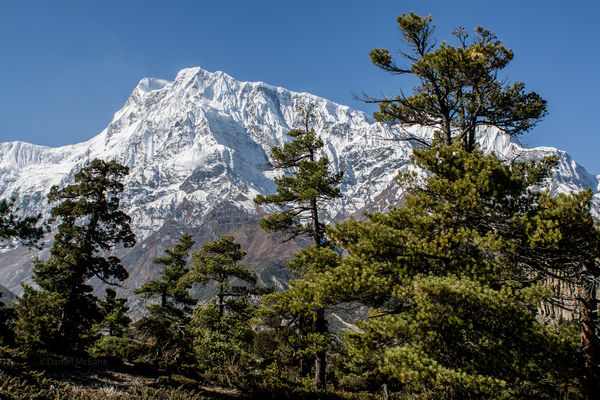
…now behind some trees
We didn’t really need that extra day since we had already spent two days in Upper Pisang, which is located at almost the same altitude and we had taken the upper trail from there and spent a night in Ngawal, several hundred meters above Manang. Nevertheless, we were not going to pass up an opportunity to take a break. On top of that, the guy who had been sick most of the trek was feeling worse than ever and was hoping a day of rest would help him recover.
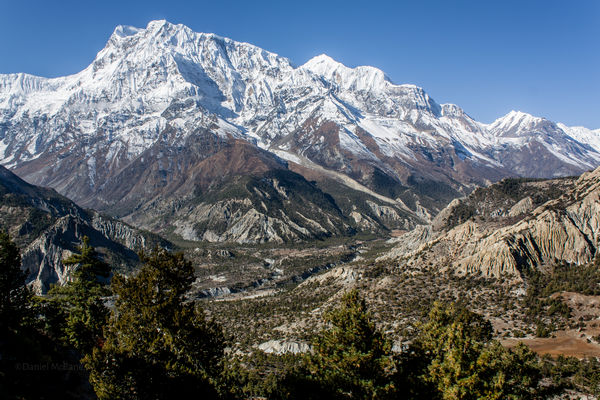
…and across the Manang valley…
Our first order of business upon arriving was finding a place to stay. Unfortunately, the friendly and cozy tea houses that are a staple around the trek do not exist in Manang. They are replaced by stale hotels run by very impersonal and not at all cozy management. The quality of the rooms is generally higher than other towns around the trek, but the same can not be said for the mattresses. While a bit of searching elsewhere usually revealed at least one guesthouse with softer mattresses than the others, we had no such luck in Manang.
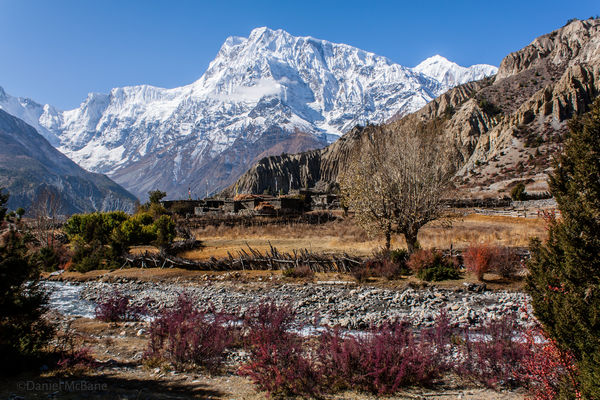
…and finally, at the end of our descent.
The price for any room is three times higher than anywhere else. The same goes for the food in the attached restaurants. The menus have far more options than those in other towns, many of them featuring various yak steaks with French-sounding gravies and price tags to match. One of the best meals I’d had in a long time was a yak steak burger in Shangri-la, China a few months earlier and it was still very fresh in my mind, so I splurged on a yak steak with a red wine and mushroom sauce. It did not match up to the burger, despite costing twice as much. It was completely average, about the same quality you would get in most chain restaurants in the US. And that’s really how all of Manang felt—like an average chain restaurant, designed only to separate you from your money, with no real personality or flair.
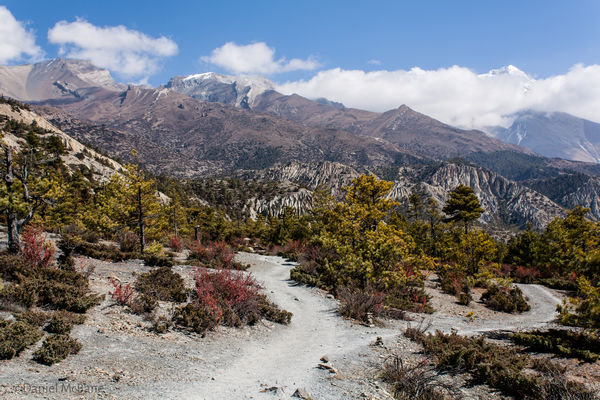
Looking back at the trail behind us
After finding a hotel, we took advantage of a free presentation about altitude sickness put on by international doctors working for an aid organization that was trying to bring basic medical care to the Tibetan villages in the area. With all the talk of altitude sickness among trekkers, much of it exaggeration and hearsay, it was nice to get some actual information from a trustworthy source.
We learned all about the causes (you might be able to guess this one) and symptoms of altitude sickness, along with ways to prevent it or to minimize the effects. As I’ve mentioned before, none of us ever had any problems with the altitude, since we took our time gaining it (not necessarily by choice), but it was an interesting presentation nonetheless. It turns out there was a lot I didn’t know about altitude sickness and now I know it.
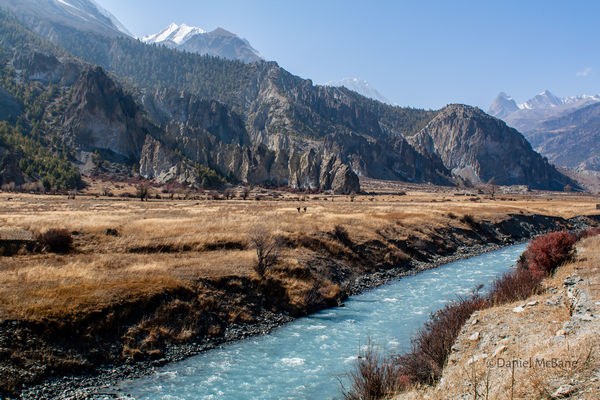
The Marsyangdi River shortly before Manang
After the presentation, we went shopping. I had filled up most of my camera’s memory cards with the amazing scenery from the previous two days and I decided to buy another one. I expected to pay more out here, so far from modern civilization, but the price was only a few dollars higher. And the card still works today, almost three years later.
I also decided to buy a pair of sweatpants, since I was not at all prepared for the freezing temperatures of the Himalayan peaks, mainly because I knew I could buy more layers if I needed them and I preferred that to carrying any unnecessary weight. Unfortunately, the largest size I could find would have comfortably fit a starving 10-year-old girl. I set out to buy sweatpants and ended up with a pair of tights. They were not comfortable, but at least they were warm. I only wore them at night and I tossed them as soon as I got over the pass and the temperature increased.
Series continued in part 11: Trekking On Our Day Off From Trekking in Manang
Thanks for the update!
Just curious, why is soft mattress important? I have done backpacking and sleeping on hard surfaces with just a sleeping pad is fine with me. Also, how do you pick your final selection of a place to stay? It seems like you do not know in advance, so, do you ask and go visit a few of them and possibly go back to the one you had already seen? Do you generally go see the room beforehand and pick the one you like? IIRC, you mentioned about the hotel front desk claiming only one room when there were many. BTW, do you feel you live in two worlds as you do not have to deal with this BS when you are in western world? Will it ever get better over there in Asia?
A soft mattress isn’t necessarily important, but it’s definitely preferable. Why be uncomfortable unless you have to?
I rarely have a room lined up in advance. I just check out a place when I arrive. If I like it, I stay; if not, I try somewhere else. Usually I’ll find a place that works for me. If none do, I stay at the one that’s the least bad.
I actually prefer the accommodation options in Asia to those in the western world. They are far cheaper, which more than makes up for everything else.
Unfortunately, I never managed to get there, but the scenery is worth the sweat of hiking!
I’m sure you’ll visit Nepal in the future. The scenery is definitely worth the effort, at least on this particular trek. I actually hope to do it again someday soon, before they finish the road. And that’s not my usual position when it comes to physical exertion.
Just discovering the site as we prepare for a trek, and I am a little nervous because I am not a big trekker person and I especially am not a fan of chain restaurants. As long as the views are still there when we get there, I think I will be OK. Great pictures by the way!
Thanks! The views will be amazing. I don’t think that will ever change, no matter how much construction they do up there. I’m not sure what the weather will be like this early in the year, though. Hopefully you get clear skies.